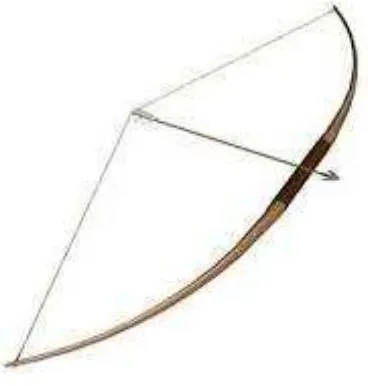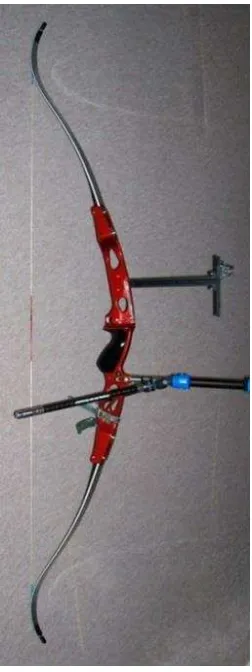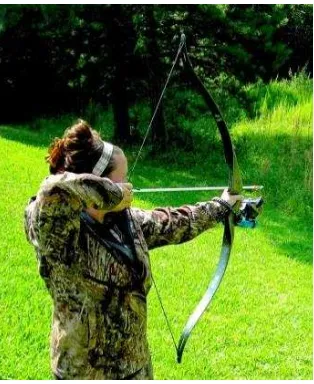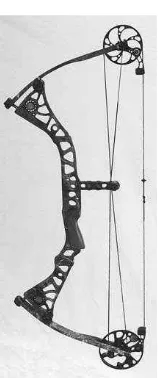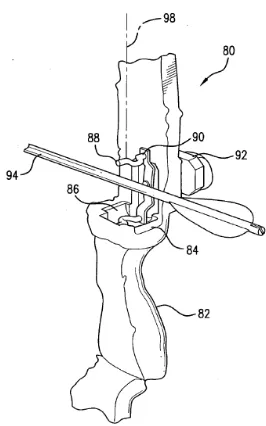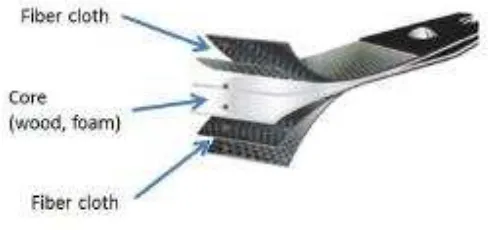DESIGN AND MANUFACTURE OF RECURVE BOW
RISER USING FUSED DEPOSITION MODELING (FDM)
AND FIBER- REINFORCED COMPOSITE MATERIAL
MOHD HAIROL AZAHA BIN JAAFAR
B051010133
UNIVERSITI TEKNIKAL MALAYSIA MELAKA
DESIGN AND MANUFACTURE OF RECURVE BOW RISER
USING FUSED DEPOSITION MODELING (FDM) AND FIBER-
REINFORCED COMPOSITE MATERIAL
This report submitted in accordance with requirement of the Universiti Teknikal
Malaysia Melaka (UTeM) for the Bachelor Degree of Manufacturing Engineering
(Manufacturing Design) (Hons.)
By
MOHD HAIROL AZAHA BIN JAAFAR B051010133
861004305093
FACULTY OF MANUFACTURING ENGINEERING
APPROVAL
This report is submitted to the Faculty of Manufacturing Engineering of UTeM
as a partial fulfillment of the requirements for the degree of Bachelor of
Manufacturing Engineering (Manufacturing Design) (Hons.). The member of the
supervisory is as follow:
………
DECLARATION
I hereby, declared this report entitled “Design and Manufacture of Recurve Bow Riser Using Fused Deposition Modeling (FDM) And Fiber- Reinforced Composite
Material” is the results of my own research except as cited in references.
Signature : ……….
Author’s Name : ………
i
ABSTRAK
Projek ini adalah untuk merangka semula dan mengeluarkan riser busur memanah recurve
menggunakan Fused Deposition Modeling (FDM) dengan meningkatkan kekuatan dan
pemilihan bahan. Satu kaedah salutan prototaip yang menggunakan gentian karbon telah
digunakan untuk meningkatkan kekuatan riser. Walau bagaimanapun, terdapat perubahan
sedikit, iaitu disebabkan ketidaksuaian kaedah salutan untuk prototaip. Pembalut kaedah
vakum telah digunakan untuk timbunan bahan komposit serat karbon ke dalam pelbagai
lapisan berlainan set. Ini kemudiannya telah diuji menggunakan Universal Testing Machine
(UTM) untuk menguji kekuatannya. Ia didapati bahawa lapisan komposit boleh menahan 0.1
KN beban. Oleh itu, mengukuhkan menggunakan bahan ini sesuai untuk menjadi terang,
ii
ABSTRACT
This project is dine to redesign and manufacture the archery recurve bow riser using Fused
Deposition Modelling (FDM) with improve in weight strength and material selection. A
method of coating the prototype using carbon fibre was used to enhance the strength of the
riser. However, there were slight changes, due to inappropriate method of coating to the
prototype. Vacuum bagging method was used to stack the carbon fibre composite material
into multiple layers, with different set of layers. This then was tested using Universal Testing
Machine (UTM) to test the strength. It is found that the layer of composite can withstand 0.1
KN of load. Thus, reinforcing using the material is suitable for it is light, easy to shape and
iii
DEDICATION
I dedicate this work to my family and many friends. A special feeling of gratitude
to my loving parents whose words of encouragement and push for tenacity ring in
my ears. I also dedicate this project to my many friends who have supported me
throughout the process. I will always appreciate all of you who have commented,
vi
ACKNOWLEDGEMENT
I would like to express my deepest appreciation to all those who provided me the
possibility to complete this report. A special gratitude I give to my final year
project supervisor, Dr. Shajahan Bin Maindin, whose contribution in stimulating
suggestions and encouragement, helped me to coordinate my project especially in
writing this report.
Furthermore I would also like to acknowledge with much appreciation the crucial
role of the staff of Faculty of Manufacturing Engineering, who gave the permission
to use all required equipment and the necessary materials to complete the task related
to my project. Special thanks go to my friends who gave suggestion regarding my
project. Last but not least, I have to appreciate the guidance given by other
supervisor as well as the panels especially in my project presentation that has
vi
2.4 Manufacturing Process 12
CHAPTER 3: METHODOLOGY 14
3.4 Using Fused Deposition Modeling (FDM) 27
3.5 Reinforced Using Fiber Composite Material 28
vii
4.6 Testing Result 36
4.6.1 Set One (1 Layer) 36
4.6.2 Set Two (3 Layers) 39
4.6.3 Set Three (5 Layers) 40
CHAPTER 5: CONCLUSION AND FUTURE WORK 46
5.1 Conclusion 46
5.2 Future Work 47
viii
LIST OF FIGURES
Figure 1: Previous Century Bow 1
Figure 2: Current Recurve Bow 2
Figure 3: Hunting Bow 2 Figure 4: Sport Recurve Bow 3 Figure 5: Using Deflex Riser Design 7 Figure 6: Using Inline Riser Design 7
Figure 18: Before & After Composite Layup Process ... 27
Figure 19: Prototype of Riser ... 29
ix
LIST OF TABLES
Table 1: Concept Selection Table 23
Table 2: Table of Scoring ... Error! Bookmark not defi 24
Table 3: Number of Composite Stacking 32
Table 4: 1 Layer... 37
Table 5: Summary for 1 Layer 37 Table 6: 3 Layer... 40
Table 7: Summary for 3Layer ... 40
Table 8: 5 Layer... 42
1
Archery is one of the most popular activities that has been known since Paleolithic, and has
been popular ever since. It is also a type of sport and is played at Olympics. Not only known
as a sport or for competition but also used as an activity such as hunting. In fact, the history
of archery starts with hunting, whereby people from Paleolithic used archery to hunt for their
living. Since then, archery had been developed through centuries to become as a sport.
The difference between previous archery and now is not much. The only difference is the
shape, design and also the technology applied on the construction of the bow and arrow. The
concept of playing is still the same, where by one need the arrow, bow and target to play
archery. Not to forget a right technique to avoid injury that could occur. Revolution of bow
and arrow has been developed from centuries. Figure 1.0 shows the pictures of bow from
previous century and current one:
Figure 1.0 (a): Previous Century Bow
2
Figure 1.0 (b): Current Recurve Bow
Archery is a very simple sport and very easy to play with. It can train one to be more focus,
plus can be act as a self-defense. There are 3 basic things needed to play archery, which are:
bow, arrow and target bad. Despite these few things, skills and techniques are also needed.
There are many types of archery bow; one that is use for hunting, sport, and etc. Bow for
hunting and sports have a different function and method to use. For the hunting bow the
archer need to pull the string up to the side of the archer eyes. Figure1.0 (c) below shows how
3
Figure 1.0 (c): Hunting Bow
For the sport bow, archer needs to pull the string and anchor it under the chin, and to make
sure the string touch the lips and the tip of the nose. Figure 1.0 (d) below shows how the
archer shoot using this type of bow:
Figure 1.0 (d): Compound Bow
Despite the type of archery, the bow use in the sport branched into two types, which are;
recurve bow and compound bow (Mary B, 2005). Recurve bow has several parts that can be
dissembled and assembled to become a complete bow. This makes it portable and easy to
carry around during tournament or etc. The parts consist of raiser, upper limb, lower limb and
string. In the archery industry nowadays, the top company for bow production is Win&Win
from Korea, and another one is Hoyt, from the America.
On the other hand, compound bow is much smaller than recurve bow. The most obvious
difference from recurve bow is that, it has cam to operate the draw of string while shooting
4
There are many design of the bow, mostly in the riser part that could affect the strength of the
bow itself. Not only the design of the raiser, but material also plays an important role on the
strength of the bow. Some of the common used material is carbon graphite, forged aluminum,
royal cross carbon(Marry B.,2005).
1.1 Problem Statement
Nowadays, there are many type of riser design for archery bow. Each of this riser has
their own weight specifically, according to the type of design and material. This
makes the archer has difficulty to handle the bow weight for a long time. In this
project, a riser with low weight but has good performance will be manufactured.
1.2 Aims
To design and manufacture a low- weight riser yet has good performance and
strength.
1.3 Objective
The objectives for this project are:
a) To redesign and manufacture the riser prototype using FDM machine.
b) To reinforced composite material to the prototype.
c) To test and analyze the prototype
1.3 Scope
The riser design is only for recurve type of bow which is used in sports. It also does
not cover the other part of the bow such as the string and limb. The material use is
5
Today riser design had been tremendously advanced and popular whereby they are so many
improvements done by the famous archery bow manufacture company such as Win & Win
and Hoyt. This result from improve research to enhance the performance of bow (Lieu,D.K,
2010). This study aims to improve the design of typical riser base on weight and strength.
Thus, this chapter touches on five important key points that are riser design, riser weight,
material use, process of manufacturing and coating of fibre layer.
2.1 Riser Design
In order to design a riser, the first thing to look up to is the aesthetic value to be
parallel with the performance of the riser. One would not want a ‘good looking’ riser
but least in performance. The dimension also plays an important role upon designing
the riser. Because the size of the user is differ from another, thus the dimension is
reach the distances needed for shooting long-distance target rounds.
6
Figure 2.11: Using Deflex Riser Design
2.1.2 Inline Riser
Inline risers have the limb pockets in line with the arrow rest. These bows are
less forgiving, but have more speed, making it easier to reach the long
distances easier. In general, this is a good compromise for a target bow.
7
2.1.3 Reflex Riser Design
Figure 2.1.3: Using Reflex Riser Design
Reflex riser has the limb pockets in front the arrow rest. These have the most
speed (and therefore, get the most distance), but can be more critical. Older
reflex bows may be more critical than newer ones.
This three types of riser could influence the speed of arrow upon release. But
the speed of arrow is not covered in this study.
There is previous riser design which focuses on movable arrow rest, which has
been patented on 2011 that help on minimizing the rotational effect of an
archer’s forehand when drawing a bow string. From the patented study, it is
said that there were many conventional arrow rest are connected to a bow riser
with a bracket. The bracket can adjoin the arrow rest to one of many different
types of bow risers, using mounting hole, with particular size and position
according to an Archery Manufacturers and Merchant’s Organization (AMO)
specification(Miroslow A. 2011).
The bracket includes a moment arm that offsets the arrow rest from and thus
not aligns with a longitudinal axis of the bow riser. From the study, this offset
makes aiming at a target more difficult for an archer. From that, the patented
8
patent; Figure 2.1.3 (a) is the perspective view of a portion of the archery bow
riser in a start position, according to one embodiment of the respective
invention.
Figure 2.1.3 (a): Perspective View of Bow Riser
While as Figure 2.2 (b) below is the perspective view of a portion of the
archery bow riser in a launch position;
9
The patent basically focuses on the ergonomic of the riser upon release. Which has
stated previously; the author claims that from the current archery riser design, it
creates difficulties for archers to aim the target. Unfortunately, this is not covered in
this study as the design suit for compound bow only. Recurve bow is simpler and does
not have any offset to make it hard to aiming the target. Thus this design is not
suitable to be applied in the project.
2.2 Bow’s Weight
Anybody who ever shoot an arrow before, definitely would know how heavy the bow
is. The weight of the limb, riser, stabilizer, sight stabilizer, the weight and other
accessories make the bow heavier. This statement however, is differing from every
type of archery bow. The hunting bow for example, seldom needs additional
accessories because, this will make the archer difficult to bring along the equipment.
Differ from sports bow, the archers definitely need accessories to enhance their bow
performance, in terms of stability, reduce vibration and etc. (Wise, Larry; n.d).
The efficiency of a bow will increase when the weight of the moving parts of the bow
is lighter. The moving parts are the limbs and the string (Lieu, D. K, 2010). This
statement shows that riser weight will not affect the efficiency of the bow either
making it heavier or lighter. But in current market, the riser has been made lighter
from time to time, in order to fulfill customer specification. Some might not want to
bring heavy equipment during tournament or go for hunting.
2.3 Material Use
Previously many materials had been used to produce riser such as, wood, aluminum,
carbon and etc. Choosing material to fabricate riser is important because, different
material has different mechanical properties such as strength, weight, and stiffness.
10
The material use must pose high strength in order to stand the vibration after the
shoot. The mechanism of arrow basically; when the archer draw the arrow, a lot of
kinetic energy is stored in the limb and string. Upon releasing, the kinetic energy is
then transferred to the riser and this will produce vibration (Lieu, D. K, 2010).
The continuous vibration will affect the riser in time and could possibly undergo
crack. Thus, there are many riser made from material that has high stiffness and
strength in order to last long. There is a design of multiple layer of material used in
this area, that is using two to three materials to produce a limb. Figure below is the
cross section of modern Olympic recurve bow limb;
Figure 2.3: Layer of Material
The material is usually fiber glass or epoxy matrix in order to produce strength and
stiffness with low weight (Lieu, D. K, 2010).
Glass fiber reinforced plastic (GFRP) composites are widely used in sports equipment
due to their multi potential properties, such as high strength to weight ratio, high
specific stiffness, high damping, high fracture toughness, good dimensional stability
and excellent corrosion resistance (Ramesh, B.; Ajay Balaji,D; 2013). The
appearanceof new materials such as carbon fiber composites, which are both lighter
and stronger than previous material have improved the performance of Olympic
recurve bows over the past two decades.
Typically the riser is fabricated from metal such as aluminum or magnesium or from
composite materials that generally lack any appreciable amount of. Upon drawing the
11
inelastic and limbs that are more flexible; producing an undesirable stresses into the
bow. Technically speaking, the stress is produced in the joints between riser and the
limbs. If left unnoticed, these stresses may compromise the structural integrity of the
bow (Pilpel, E 2013).
Moreover, Pilpel also mention that in bows and crossbows that have risers fabricated
from substantially inelastic material, the opportunity for stress- related cracking to
develop as result of repeated use increases. Apart from that, climate changes also a
key to the deterioration of the microstructure of the material of the riser, which later
will reduce the useful life of the bow. Furthermore, this deterioration of
microstructure too, can lead to visible defects in the riser which in turn can affect the
overall appearance of the bow. The problem is explained by Pilpel; climate changes
such as high temperature that results in increases creep or degradation of the
composite matrix or the adhesive used, and variation in humidity.
Pilpel then patented an archery bow, mainly riser which it’s general objective is to
provide an archery bow having components fabricated from a material that overcomes
the problems stated below.
2.4 Manufacturing Process
There are many processes used to fabricate riser, be it conventional machining or non-
conventional machining. Not only that, previous process also used die casting
(arundown.org.uk). But mostly, the popular company such as Hoyt and Win&Win
Archery use machining due to good surface finish and less time consume.
For this study, FDM machine is use to fabricate the prototype. This one also will help
in testing the strength of the material. An intake manifold were fabricate using FDM
to develop a new design which has result in reduce of weight, improved charge
distribution to compare with traditionally- manufactured aluminum counterpart. The
use of FDM in order to optimize a certain design is useful as one could replicate the
